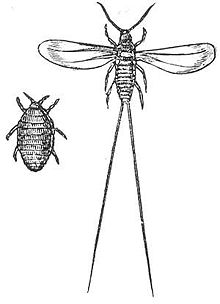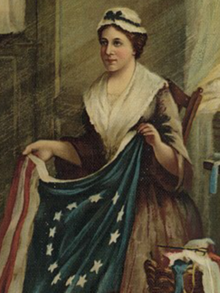Portal maintenance status: (June 2018)
|
The Clothing Portal

Clothing (also known as clothes, garments, dress, apparel, or attire) is any item worn on the body. Typically, clothing is made of fabrics or textiles, but over time it has included garments made from animal skin and other thin sheets of materials and natural products found in the environment, put together. The wearing of clothing is mostly restricted to human beings and is a feature of all human societies. The amount and type of clothing worn depends on gender, body type, social factors, and geographic considerations. Garments cover the body, footwear covers the feet, gloves cover the hands, while hats and headgear cover the head, and underwear covers the private parts.
Clothing has significant social factors as well. Wearing clothes is a variable social norm. It may connote modesty. Being deprived of clothing in front of others may be embarrassing. In many parts of the world, not wearing clothes in public so that genitals, breast, or buttocks are visible could be considered indecent exposure. Pubic area or genital coverage is the most frequently encountered minimum found cross-culturally and regardless of climate, implying social convention as the basis of customs. Clothing also may be used to communicate social status, wealth, group identity, and individualism. (Full article...)
Textile is an umbrella term that includes various fiber-based materials, including fibers, yarns, filaments, threads, different fabric types, etc. At first, the word "textiles" only referred to woven fabrics. However, weaving is not the only manufacturing method, and many other methods were later developed to form textile structures based on their intended use. Knitting and non-woven are other popular types of fabric manufacturing. In the contemporary world, textiles satisfy the material needs for versatile applications, from simple daily clothing to bulletproof jackets, spacesuits, and doctor's gowns. (Full article...)
Textile arts are arts and crafts that use plant, animal, or synthetic fibers to construct practical or decorative objects. (Full article...)
Selected articles - load new batch
-
Image 1Mamianqun ornamented with Chinese goldwork and embroideries, a traditional skirt of the Han Chinese, Qing dynasty
Goldwork is the art of embroidery using metal threads. It is particularly prized for the way light plays on it. The term "goldwork" is used even when the threads are imitation gold, silver, or copper. The metal wires used to make the threads have never been entirely gold; they have always been gold-coated silver or cheaper metals, and even then the "gold" often contains a very low percent of real gold. Most metal threads are available in silver and sometimes copper as well as gold; some are available in colors as well.
Goldwork is always surface embroidery and free embroidery; the vast majority is a form of laid work or couching; that is, the gold threads are held onto the surface of the fabric by a second thread, usually of fine silk. The ends of the thread, depending on type, are simply cut off, or are pulled through to the back of the embroidery and carefully secured with the couching thread. A tool called a mellore or a stilleto is used to help position the threads and create the holes needed to pull them through. The threads most often have metal or gold leaf wound around a textile thread, or threads treated with an adhesive and rolled in powdered gold or other metal. (Full article...) -
Image 2

Court Ladies Preparing Newly Woven Silk, a Chinese silk painting sucby Emperor Huizong of Song, early 12th century.
The production of silk originated in Neolithic China within the Yangshao culture (4th millennium BC). Though it would later reach other places in the world, the art of silk production remained confined to China until the Silk Road opened at 114 BC. Even after trade opened, China maintained a virtual monopoly over silk production for another thousand years. The use of silk within China was not confined to clothing alone, and silk was used for a number of applications, such as writing. Within clothing, the color of silk worn also held social importance, and formed an important guide of social class during the Tang dynasty of China.
Silk cultivation had reached Japan by 300 AD, and by 552 AD the Byzantine Empire managed to obtain silkworm eggs and were able to begin silkworm cultivation while the Arabs also started to manufacture silk at around the same time. As a result of the spread of sericulture, Chinese silk exports became less important, although they still maintained dominance over the luxury silk market. The Crusades brought silk production to Western Europe, in particular to many Italian states, which saw an economic boom exporting silk to the rest of Europe. Developments in the manufacturing technique also started to take place during the Middle Ages (5th to 15th centuries) in Europe, with devices such as the spinning wheel first appearing at this time. During the 16th century, France joined Italy in developing a successful silk trade, although the efforts of most other nations to develop a silk industry of their own were unsuccessful. (Full article...) -
Image 3The Vestiarium Scoticum (full title, Vestiarium Scoticum: from the Manuscript formerly in the Library of the Scots College at Douay. With an Introduction and Notes, by John Sobieski Stuart) is a book which was first published in 1842 by William Tait of Edinburgh in a limited edition. John Telfer Dunbar, in his seminal work History of Highland Dress, referred to it as "probably the most controversial costume book ever written".
The book itself is purported to be a reproduction, with colour illustrations, of a 15th-century manuscript on the clan tartans of Scottish families. Shortly after its publication it was denounced as a forgery, and the "Stuart" brothers who brought it forth were also denounced as impostors for claiming to be the grandsons of Bonnie Prince Charlie. It is generally accepted today that neither the brothers themselves nor the Vestiarium are what they were purported to be. (Full article...) -
Image 4
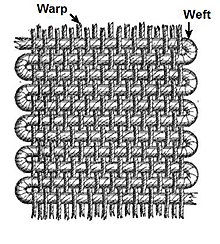
Warp and weft in plain weaving
Weaving is a method of textile production in which two distinct sets of yarns or threads are interlaced at right angles to form a fabric or cloth. Other methods are knitting, crocheting, felting, and braiding or plaiting. The longitudinal threads are called the warp and the lateral threads are the weft, woof, or filling. The method in which these threads are interwoven affects the characteristics of the cloth.
Cloth is usually woven on a loom, a device that holds the warp threads in place while filling threads are woven through them. A fabric band that meets this definition of cloth (warp threads with a weft thread winding between) can also be made using other methods, including tablet weaving, back strap loom, or other techniques that can be done without looms.
The way the warp and filling threads interlace with each other is called the weave. The majority of woven products are created with one of three basic weaves: plain weave, satin weave, or twill weave. Woven cloth can be plain or classic (in one colour or a simple pattern), or can be woven in decorative or artistic design. (Full article...) -
Image 5
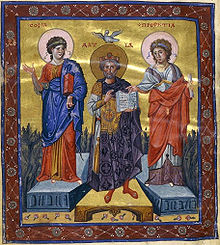
David, between personifications of Wisdom and Prophecy, is depicted in a chlamys of patterned Byzantine silk. Paris Psalter, 10th century.
Byzantine silk is silk woven in the Byzantine Empire (Byzantium) from about the fourth century until the Fall of Constantinople in 1453.
The Byzantine capital of Constantinople was the first significant silk-weaving center in Europe. Silk was one of the most important commodities in the Byzantine economy, used by the state both as a means of payment and of diplomacy. (Full article...) -
Image 6Batik from Yogyakarta, late nineteenth century
Batik is a dyeing technique using wax resist. The term is also used to describe patterned textiles created with that technique. Batik is made by drawing or stamping wax on a cloth to prevent colour absorption during the dyeing process. This creates a patterned negative when the wax is removed from the dyed cloth. Artisans may create intricate coloured patterns with multiple cycles of wax application and dyeing. Patterns and motifs vary widely even within countries. Some pattern hold deep symbolic significance and used only in certain occasions, while some were created to satisfy market demand and fashion trends.
Resist dyeing using wax has been practised since ancient times and it is attested in several world culture such as Egypt, southern China (especially among hill tribes like the Miao, Bouyei and Gejia peoples), India, Indonesia, Malaysia, Nigeria, and Sri Lanka. The technique developed in Indonesia (especially in Java) is among the most sophisticated, although its antiquity is difficult to determine. It first became widely known outside of southeast Asia when it was described in the 1817 The History of Java, leading to significant collecting efforts and scholarly studies to the tradition and other batik crafts. Javanese batik was subject to several innovations in the 19th to early 20th century, such as the use of stamp that increase production. Many workshops and artisans are still active today, creating a wide range of products and influencing a number of other textile traditions and artists (Full article...) -
Image 7

The Harris Tweed Orb Mark
The Harris Tweed Authority (HTA) is an independent statutory public body created by the Harris Tweed Act 1993, replacing the Harris Tweed Association, which was formed in 1910. The Harris Tweed Authority is charged with the general duty of furthering the Harris Tweed industry as a means of livelihood for those who live in the Outer Hebrides of Scotland.
The Harris Tweed Authority is responsible for safeguarding the standard and reputation of Harris Tweed, promoting awareness of the cloth internationally, and disseminating information about material falling within the definition of Harris Tweed and articles made from it. (Full article...) -
Image 8
The cochineal (/ˌkɒtʃɪˈniːl,ˈkɒtʃɪniːl/ KOTCH-ih-NEEL, -neel, US also /ˌkoʊtʃɪˈniːl,ˈkoʊtʃɪniːl/ KOH-chih-; Dactylopius coccus) is a scale insect in the suborder Sternorrhyncha, from which the natural dye carmine is derived. A primarily sessile parasite native to tropical and subtropical South America through North America (Mexico and the Southwest United States), this insect lives on cacti in the genus Opuntia, feeding on plant moisture and nutrients. The insects are found on the pads of prickly pear cacti, collected by brushing them off the plants, and dried.
The insect produces carminic acid that deters predation by other insects. Carminic acid, typically 17–24% of dried insects' weight, can be extracted from the body and eggs, then mixed with aluminium or calcium salts to make carmine dye, also known as cochineal. Today, carmine is primarily used as a colorant in food and in lipstick (E120 or Natural Red 4). (Full article...) -
Image 9
Elizabeth Griscom Ross (née Griscom; January 1, 1752 – January 30, 1836), also known by her second and third married names, Ashburn and Claypoole, was an American upholsterer who was credited by her relatives in 1870 with making the second official U.S. flag, accordingly known as the Betsy Ross flag. Though most historians dismiss the story, Ross family tradition holds that General George Washington, commander-in-chief of the Continental Army and two members of a congressional committee—Robert Morris and George Ross—visited Mrs. Ross in 1776. Mrs. Ross convinced George Washington to change the shape of the stars in a sketch of a flag he showed her from six-pointed to five-pointed by demonstrating that it was easier and speedier to cut the latter. However, there is no archival evidence or other recorded verbal tradition to substantiate this story of the first U.S. flag. It appears that the story first surfaced in the writings of her grandson in the 1870s (a century after the fact), with no mention or documentation in earlier decades.
Ross made flags for the Pennsylvania Navy during the American Revolution. After the Revolution, she made U.S. flags for over 50 years, including 50 garrison flags for the U.S. Arsenal on the Schuylkill River during 1811. The flags of the Pennsylvania navy were overseen by the Pennsylvania Navy Board. The board reported to the Pennsylvania Provincial Assembly's Committee of Safety. In July 1775, the President of the Committee of Safety was Benjamin Franklin. Its members included Robert Morris and George Ross. At that time, the committee ordered the construction of gunboats that would eventually need flags as part of their equipment. As late as October 1776, Captain William Richards was still writing to the Committee of Safety to request the design that he could use to order flags for the fleet. (Full article...) -
Image 10
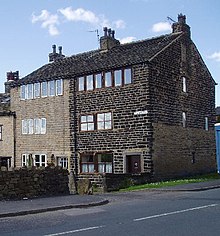
Former woollen weavers' cottages in Wardle, Greater Manchester, England.
A weavers' cottage was (and to an extent still is) a type of house used by weavers for cloth production in the putting-out system sometimes known as the domestic system.
Weavers' cottages were common in Great Britain, often with dwelling quarters on the lower floors and loom-shop on the top floor. Cellar loomshops on the ground floor or in the basement were found where cotton was woven, as they provided high humidity. A loom-shop can be often recognised by a long row of windows which provided maximum light for the weaver. (Full article...) -
Image 11
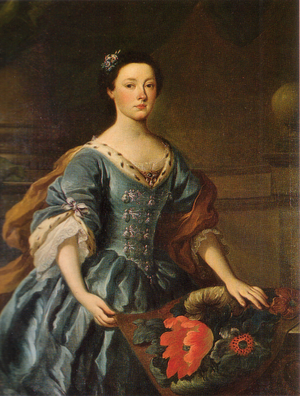
Lady Jane Allgood displays her embroidery of an anemone and tulips worked in long-and-short stitch, part of a set of 18th century chair covers and screens which survive at Nunwick Hall, although now much faded.
English embroidery includes embroidery worked in England or by English people abroad from Anglo-Saxon times to the present day. The oldest surviving English embroideries include items from the early 10th century preserved in Durham Cathedral and the 11th century Bayeux Tapestry, if it was worked in England. The professional workshops of Medieval England created rich embroidery in metal thread and silk for ecclesiastical and secular uses. This style was called Opus Anglicanum or "English work", and was famous throughout Europe.
With the Protestant Reformation of the 16th century, the focus of English embroidery increasingly turned to clothing and household furnishings, leading to another great flowering of English domestic embroidery in the Elizabethan and Jacobean eras. The end of this period saw the rise of the formal sampler as a record of the amateur stitcher's skills. Curious fashions of the mid-17th century were raised work or stumpwork, a pictorial style featuring detached and padded elements, and crewel work, featuring exotic leaf motifs worked in wool yarn. (Full article...) -
Image 12

Striking CIO mill workers in Georgia, May 1941.
Emil Rieve (June 8, 1892 – January 24, 1975) was an American labor leader. He was president of the Textile Workers Union of America (TWUA) from 1939 to 1956, a vice president of the Congress of Industrial Organizations (CIO) from 1939 to 1955, and a vice president of the AFL-CIO from 1955 to 1960.
Emil Rieve was born in Poland and moved to Pennsylvania as a child. He left school early and first became a union member at age fifteen, quickly rising within the union hierarchy. He organized his first strike in 1930 in Reading, Pennsylvania. His aggressive drives to unionize the region's textile workers and achieve union recognition led to the Reading Formula of 1933 in negotiating with the National Labor Board, a precedent which resolved large numbers of other labor disputes. Rieve was a major figure in the unsuccessful textile workers strike of 1934. When the Congress of Industrial Organizations formed the following year, Rieve received international recognition for his efforts to avoid a rift with the American Federation of Labor. (Full article...) -
Image 13
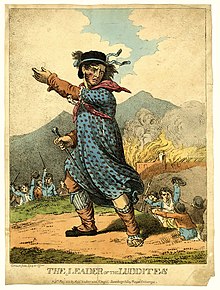
The Leader of the Luddites, 1812. Hand-coloured etching.
The Luddites were members of a 19th-century movement of English textile workers who opposed the use of certain types of automated machinery due to concerns regarding decreased pay for textile workers and a perceived reduction of output quality, and often destroyed the machines in organised raids. Members of the group referred to themselves as Luddites, self-described followers of "Ned Ludd", a mythical weaver whose name was used as a pseudonym in threatening letters to mill owners and government officials.
The Luddite movement began in Nottingham, England, and spread to the North West and Yorkshire between 1811 and 1816. Mill and factory owners took to shooting protesters and eventually the movement was suppressed by legal and military force, which included execution and penal transportation of accused and convicted Luddites. (Full article...) -
Image 14

Denim fabric dyed with indigo
Denim is a sturdy cotton warp-faced textile in which the weft passes under two or more warp threads. This twill weave produces a diagonal ribbing that distinguishes it from cotton duck. Denim, as it is recognized today, was first produced in Nîmes, France.
Denim is available in a range of colors, but the most common denim is indigo denim in which the warp thread is dyed while the weft thread is left white. As a result of the warp-faced twill weaving, one side of the textile is dominated by the blue warp threads, and the other side is dominated by the white weft threads. Jeans fabricated from this cloth are thus predominantly white on the inside. Denim is used to create a wide variety of garments, accessories, and furniture. (Full article...) -
Image 15Kimono for a young woman (furisode), Japan, 1912–1926
The Khalili Collection of Kimono is a private collection of more than 450 Japanese kimono assembled by the British-Iranian scholar, collector and philanthropist Nasser D. Khalili. It is one of eight collections assembled, published and exhibited by Khalili, each of which is considered to be among the most important collections within their respective fields.
The Khalili Collection of Kimono includes formal, semi-formal, and informal kimono made for men, women, and children, illustrating the evolution of the kimono through cut, construction, materials, and decorative techniques from the 17th through the 20th centuries, with kimono representing the Edo period, the Meiji period, the Taishō period, and the Shōwa period. The kimono within the collection are not on permanent display, but are periodically lent or donated in part to cultural institutions; including the Kremlin Museums in Moscow and the Victoria and Albert Museum in London. Khalili, who also owns a collection of Meiji-era Japanese art, describes kimono as "one of the wonders of the world." He started the kimono collection with the aim of collecting and cataloguing cultural works that were not already actively being collected. (Full article...)
Did you know (auto generated)

- ... that after being criticized for dressing "like a doll" at an important meeting, pioneering Russian feminist Anna Filosofova replied that "clothes do not make the woman"?
- ... that during a renovation of 4 Park Avenue, workers found a sealed room with women's clothes and shoes that was not in the building's blueprints?
- ... that Jacqueline Kennedy did not want to make her clothes the focus of her 1962 goodwill tour of India and Pakistan, but still wore 22 different outfits in the first nine days?
- ... that Church Clothes 4 deals with Christian hip hop artist Lecrae's faith deconstruction and reconstruction?
- ... that Liberian paramount chief Tamba Taylor worked as a tailor and claimed to have sewn clothes for Ethiopian emperor Haile Selassie and Ghanaian president Kwame Nkrumah?
- ... that during the Second World War, the British government's campaign Make-Do and Mend encouraged the public to fashion men's clothes into womenswear?
More Did you know
- ...that cross stitches (example pictured) are part of the embroidery traditions of the Balkans, Middle East, Afghanistan, Colonial America and Victorian England?
- ...that Bulgarian Dobri Zhelyazkov founded the first textile factory in the Ottoman Empire?
- ...that the Montgomery Worsted Mills, a Registered Historic Place in Montgomery, New York, now earn most of their money by generating hydroelectric power from the nearby Wallkill River, rather than the manufacture of textiles?
Related portals
Selected image

| Credit: Jacob Ferdinand Voet |
Point de Venise (also Gros Point de Venise) is a Venetian needle lace from the 17th century characterized by scrolling floral patterns with additional floral motifs worked in relief (in contrast with the geometric designs of the earlier reticella).
General images - load new batch
-
Image 1A woman in Bengal region in the eastern part of the Indian subcontinent, clad in fine Bengali muslin, 18th century. (from History of clothing and textiles)
-
Image 2Textile machinery at the Cambrian Factory, Llanwrtyd, Wales in the 1940s (from History of clothing and textiles)
-
Image 3Albrecht Dürer's drawing contrasts a well-turned out bourgeoise from Nuremberg (left) with her counterpart from Venice. The Venetian lady's high chopines make her look taller. (from Fashion)
-
Image 4A Mexican sports reporter Inés Sainz wearing a little black dress and knee-high boots (from Fashion)
-
Image 5Bold floral patterned silks, 15th century (from History of clothing and textiles)
-
Image 6Latin dancers in their costumes. The woman is wearing backless dress with deep slits on its lower portion, while the man is wearing a shirt with top buttons open. (from Fashion)
-
Image 7Indigenous Americas Map Tunic designed in 2018 by Carla Fernández and Pedro Reyes for Taller Flora. (from Fashion)
-
Image 8Model with a modern dress reflecting the current fashion trend at a fashion show, Paris, 2011 (from Fashion)
-
Image 9Jacqueline Kennedy, the wife of President John F. Kennedy, made pink a popular high-fashion color. (from Fashion)
-
Image 10Marie Antoinette, wife of Louis XVI, was a leader of fashion. Her choices, such as this 1783 white muslin dress called a chemise a la Reine, were highly influential and widely worn. (from Fashion)
-
Image 11Hindu lady wearing sari, one of the most ancient and popular pieces of clothing in the Indian subcontinent. (from Fashion)
-
Image 1214th-century Italian silk damasks (from History of clothing and textiles)
-
Image 13Slashing at its height: Henry IV, Duke of Saxony, c. 1514 (from History of clothing and textiles)
-
Image 14Celebrities such as Britney Spears have popularized the concept of wearing underwear as outerwear. (from Fashion)
-
Image 16This 1921 clipping from the St. Louis Post-Dispatch, with story and drawings by Marguerite Martyn, represents the saturation newspaper coverage given to society women at a fashionable dance. (from Fashion)
-
Image 17Gross sales of goods vs IP laws (US 2007) (from Fashion)
-
Image 20Liu Wen, supermodel, walks the runway modeling fashions by designer Diane von Fürstenberg at New York Fashion Week 2013. (from Fashion)
-
Image 21Edgar I of England in short tunic, hose, and cloak, 966 (from History of clothing and textiles)
-
Image 22Tie dye vendor, July 2013 (from Fashion)
-
Image 23The Boxer Codex, showing the attire of a Classical period Filipino, made of silk and cotton (from History of clothing and textiles)
-
Image 25Gensei Kajin Shu by Yoshu Chikanobu, 1890. Various styles of traditional Japanese clothing and Western styles. (from Fashion)
-
Image 28A see-through top worn along with pasties by a model at a fashion show in US, 2017. Such fashion trends get popularised through media. (from Fashion)
-
Image 29A French reinterpretation of Spanish fashion, with elaborate reticella ruff, 1609 (from History of clothing and textiles)
-
Image 30Timberland boots are an everyday shoe in streetwear. (from Fashion)
-
Image 31Estonian national clothes are a fine example of change in clothing after the Industrial Revolution. They changed a lot during 18th and 19th of century with the addition of new types of colors (like aniline dyes), placement of colors (like lengthwise stripes) and with the addition of new elements (like waistcoats). By the end of the 19th century they went out of use in most of the country (except more remote places as in Kihnu island) and it was only in mid 20th century when they once again gained popularity and now as a formal clothing. Members of University of Tartu Folk Art Ensemble wearing clothes specific to Kihnu island, Tori Parish (women in red skirts) and Tõstamaa area (men in brown clothing). (from History of clothing and textiles)
Selected quote
| The King's colours were white and black, which he always wore in honour of the Duchess of Valentinois, who was a widow. The Duke of Ferrara and his retinue had yellow and red. Monsieur de Guise's carnation and white. It was not known at first for what reason he wore those colours, but it was soon remembered that they were the colours of a beautiful young lady whom he had been in love with, while she was a maid, and whom he yet loved though he durst not show it. The Duke de Nemours had yellow and black; why he had them could not be found out: Madam de Cleves only knew the reason of it; she remembered to have said before him she loved yellow, and that she was sorry her complexion did not suit that colour. As for the Duke, he thought he might take that colour without any indiscretion, since not being worn by Madam de Cleves it could not be suspected to be hers. |
Main topics
Recognized content
Extended content
| ||
|---|---|---|
Featured articlesGood articlesFeatured pictures
Featured portals
|
Subcategories
WikiProjects
- Parent project
Knowledge (XXG):WikiProject Arts
- Main project
- Participants
- Related projects
WikiProject Fashion • WikiProject Knots • WikiProject Sculpture • WikiProject Visual arts
What are WikiProjects?
Things you can do
Associated Wikimedia
The following Wikimedia Foundation sister projects provide more on this subject:
-
Commons
Free media repository -
Wikibooks
Free textbooks and manuals -
Wikidata
Free knowledge base -
Wikinews
Free-content news -
Wikiquote
Collection of quotations -
Wikisource
Free-content library -
Wikiversity
Free learning tools -
Wiktionary
Dictionary and thesaurus



